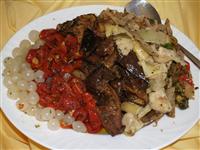This course teaches you how to develop a well balanced diet. Topics covered include how cooking and food processing affect nutrition, recommended nutrient intakes, assessing nutritional needs, planning a balanced diet, timing of meals, needs for special people/groups.
COURSE STRUCTURE
 This course is divided into eight lessons as follows:.
This course is divided into eight lessons as follows:.
- Cooking And Its Effect On Nutrition
- Food Processing And Its Effect On Nutrition
- Recommended Daily Intake Of Nutrients
- Vitamins
- Minerals
- Planning A Balanced Diet
- Assessing Nutritional Status & Needs
- Timing Of Meals & Needs For Special Groups
 AIMS
AIMS
- Determine appropriate food preparation for different foods, in relation to food value for human health.
- Explain the characteristics of food processing techniques and their implications for human health.
- Recommend daily food intakes for people with differing nutritional needs.
- Manage dietary intake of more significant vitamins including B and C complex vitamins for good health.
- Manage dietary requirements of significant minerals including calcium & iron for good health.
- Plan in detail, an appropriate seven day diet plan, for an “average” adult.
- Determine dietary needs of different individuals.
- Plan diets to achieve different, specific purposes.
- Plan diets for specific needs for people at different stages of life.
 WHAT THE COURSE COVERS
WHAT THE COURSE COVERS
Here are just some of the things you will be doing:
- Determine the reasons for cooking food.
- Compare different methods of cooking food in terms of their effect on both health and nutrition.
- Explain the effects on nutrition of cooking different types of foods, for different periods of time, including: *Meat *Fish *Eggs *Milk *Plant Foods.
- Explain how meat can be ensured to be fit for human consumption in a raw state, such as in sushi and in smallgoods.
- Distinguish between function, effects, and chemistry of different types of food additives, in food preparation, including: *Colours *Preservatives *Antioxidants *Vegetable gums *Flavourings *Thickeners *Anti caking agents *Bleaches *Emulsifiers *Humectants *Food acids *Mineral salts.
- Evaluate taste and nutritional effects of adding different specified flavourings to five different specified food dishes, including: *Salt *Sugar *Herbs *Wines.
- Explain, giving six examples of specific foods, how “freshness” of different specified foods, impacts upon nutrient status of those foods.
- Explain how physical treatment of different specified foods (eg. cutting or crushing), may affect the food benefit of that food, including: *digestibility *keeping quality *nutrient status.
- Explain different heat treatments for food preservation; in terms of the process, function and affects; including: *drying *canning *bottling *pasteurisation.
- Explain freezing of food, in terms of the process, function and affects.
- Define examples of each of the following types of food additives: *Colours *Preservatives *Antioxidants *Vegetable gums *Flavourings *Thickeners *Anti caking agents *Bleaches *Emulsifiers *Humectants *Food acids *Mineral salts.
- Distinguish between function, effects, and chemistry of different types of food additives, in food preservation, including: *Colours *Preservatives *Antioxidants *Vegetable gums *Flavourings *Thickeners *Anti caking agents *Bleaches *Emulsifiers *Humectants *Food acids *Mineral salts.
- Analyse in a report, the effects of food additives found in three different supermarket food items, selected by the learner.
- Explain problems that may result from food additives including: *allergic reactions *hyperactivity in children.
- Explain different dehydration processes, in terms of the process, function and affects.
- Explain use of food processing techniques applied to six different common foods with respect to food quality, storage life and cost.
- Compare the use of different food processing techniques on the same food, through in terms of the process, function and effect.
- Demonstrate five different food processing techniques, by independently preparing samples to a commercial standard.
- Compare recommended dietary intake information from three different sources.
- Explain how food requirements vary, in terms of components and quality, at different ages, including: *babies *children *teenagers *young adults *elderly people.
- Recommend daily food intake requirements for a variety of four different people who the learner isfamiliar with (e.g. elderly, young children, active young adults), listing components of a typical daily intake together with a profile of the person.
- List quality food sources of C complex vitamins in order of richest to poorest source.
- List quality food sources of B complex vitamins in order of richest to poorest source.
- Explain nutrient disorders associated with three different significant vitamin imbalances, including vitamin B complex, vitamin C, and one other vitamin.
- Evaluate two different people the learner is familiar with, with respect to vitamin intake, lifestyle and health status, to determine if vitamin B & C needs are being satisfied.
- List food sources of calcium in order of richest to poorest source.
- List food sources of iron in order of richest to poorest source.
- Distinguish nutrient disorders associated with calcium and iron imbalances, in terms of diagnosis and significance.
- Evaluate two different people the learner is familiar with, with respect to mineral intake, lifestyle and health status, to determine if mineral requirements including calcium and iron needs, are being met.
- Develop a questionnaire to analyse the dietary requirements of a person.
- Analyse the diet, lifestyle and general health of three different individuals and compare the individuals analysed.
- Recommend aspects of diet which could be improved for individuals analysed.
- Explain discrepancies detected between different sources of dietary recommendations.
- Conduct a self assessment of dietary practices, determining in a summary report, areas of deficiency in the learners normal diet.
- Explain the significance of considering medical history when diet planning.
- Prepare an appropriate diet plan over a seven day period, for an “average” adult.
- Compare changes in dietary requirements for people at different stages of life,including: Nursing mothers, Babies, Young children, Teenagers, Young adults, Elderly.
- Develop a five day menu for a ten year old child.
- Prepare a one day menu for an immobile elderly person.
- List unique dietary requirements for different types of people including: Weight lifters, People suffering obesity, People with coronary disease, Diabetics, People with gastric problems.
- Plan a three day menu for a serious weight lifter.
- Plan a diet for an obese person wishing to reduce weight.
- Plan a healthy diet for a thin person wishing to gain weight.





